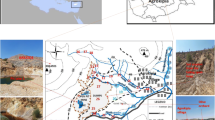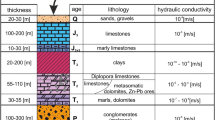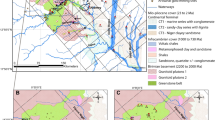Abstract
The Alto da Várzea radium mine (AV) exploited ore and U-bearing minerals, such as autunite and torbernite. The mine was exploited underground from 1911 to 1922, closed in 1946 without restoration, and actually a commercial area is deployed. Stream sediments, soils and water samples were collected between 2008 and 2009. Stream sediments are mainly contaminated in As, Th, U and W, which is related to the AV radium mine. The PTEs, As, Co, Cr, Sr, Th, U, W, Zn, and electrical conductivity reached the highest values in soils collected inside the mine influence. Soils are contaminated with As and U and must not be used for any purpose. Most waters have pH values ranging from 4.3 to 6.8 and are poorly mineralized (EC = 41–186 µS/cm; TDS = 33–172 mg/L). Groundwater contains the highest Cu, Cr and Pb contents. Arsenic occurs predominantly as H2(AsO4)− and H(AsO4)2−. Waters are saturated in goethite, haematite and some of them also in lepidocrocite and ferrihydrite, which adsorbs As (V). Lead is divalent in waters collected during the warm season, being mobile in these waters. Thorium occurs mainly as Th(OH)3(CO3)−, Th(OH)2(CO3) and Th(OH)2(CO3) 2−2 , which increase water Th contents. Uranium occurs predominantly as UO2CO3, but CaUO2(CO3) 2−3 and CaUO2(CO3)3 also occur, decreasing its mobility in water. The waters are contaminated in NO2 −, Mn, Cu, As, Pb and U and must not be used for human consumption and in agricultural activities. The water contamination is mainly associated with the old radium mine and human activities. A restoration of the mining area with PTE monitoring is necessary to avoid a public hazard.






Similar content being viewed by others
References
Acosta, J. A., Faz, A., Martinez, S., Zornoza, R., Carmona, D. M., & Kabas, S. (2011). Multivariate statistical and GIS-based approach to evaluate heavy metals behavior in mine sites for future reclamation. Journal Geochemical Exploration, 109, 8–17.
Albuquerque, M. T. D., & Antunes, I. M. H. R. (2015). Uranium Spatio-temporal variability in groundwater—An environmental risk assessment case study. In J. R. Nelson (Ed.), Uranium: Sources, exposure and environmental effects; Chapter 7 (pp. 145–147). New York: Nova Publishers. ISBN 978-1-63482-827-7 (e-book).
Alloway, J. (1995). Heavy metals in soils (2nd ed., p. 368). London: Blackie Academic & Professional.
ANDRA. (2009). ThermoChimie version 7b, C.RP.ASTR.O4.0032.
Andrew, S., & Sutherland, R. A. (2004). Cu, Pb and Zn contamination in Nuuanu Watershed, Oahu, Hawaii. Science Total Environment, 324, 173–182.
Antunes, I. M. H. R., & Albuquerque, M. T. D. (2013). Using indicator kriging for the evaluation of arsenic potential contamination in an abandoned mining area (Portugal). Science Total Environment, 442, 545–552.
Antunes, I. M. H. R., Gomes, M. E. P., Neiva, A. M. R., Carvalho, P. C. S., & Santos, A. C. T. (2016). Potential risk assessment in stream sediments, soils and waters after remediation in an abandoned W > Sn mine (NE Portugal). Ecotoxicology and Environmental Safety, 133, 135–145.
Bilotta, G. S., Burnside, N. G., Cheek, L., Dunbar, M. J., Grove, M. K., Harrison, C., et al. (2012). Developing environment-specific water quality guidelines for suspended particulate matter. Water Research, 46, 2324–2332.
Boularbah, A., Schwartz, C., Bitton, G., & Morel, J. L. (2006). Heavy metal contamination from mining sites in south Morocco. 1. Use of a biotest to assess metal toxicity of tailings and soils. Chemosphere, 63, 802–810.
Cabral Pinto, M. M. S., Silva, M. M. V. G., & Neiva, A. M. R. (2008). Geochemistry of U-bearing minerals from the Vale de Abrutiga uranium mine area, central Portugal. Neues Jahrbuch Mineralogie, 185, 183–198.
Cabral Pinto, M. M. S., Silva, M. M. V. G., & Neiva, A. M. R. (2009). Uranium minerals from a Portuguese Variscan peraluminous granite, its alteration, and related uranium-quartz veins. In G. H. Wolfe (Ed.), Uranium: Compounds, isotopes and applications (pp. 287–318). New York: Nova Science.
Cardoso, J. C., Bessa, M. T., & Marado, M. B. (1973). Carta dos Solos de Portugal (1:1000000).
Carvalho, F. P. (2014). The national radioactivity monitoring program for the regions of uranium mines and uranium legacy sites in Portugal. Procedia Earth and Planetary Science, 8, 33–37.
Carvalho, P. C. S., Neiva, A. M. R., & Silva, M. M. V. G. (2012). Assessment to the potential mobility and toxicity of metals and metalloids in soils contaminated by old Sb-Au and As-Au mines (NW Portugal). Environmental Earth Sciences, 65, 1215–1230.
Carvalho, P. C. S., Neiva, A. M. R., Silva, M. M. V. G., & Antunes I. M. H. R. (2013). Metal and metalloid leaching from tailings into stream water and sediments in the old Ag–Pb–Zn Terramonte mine, northern Portugal. Environmental Earth Sciences, 71(5), 2029–2041.
Carvalho, P. C. S., Neiva, A. M. R., Silva, M. M. V. G., & Ferreira da Silva, E. A. (2014). Geochemical comparison of waters and stream sediments close to abandoned Sb–Au and As–Au mining areas, northern Portugal. Chemie der Erde, 74(2), 267–283.
Cui, Y., & Xin, D. (2011). Soil heavy metal and wheat phytotoxicity in the vicinity of an abandoned lead–zinc mine in Shangyu City, eastern China. Environmental Earth Sciences, 62, 257–264.
Decreto Ministeriale. (1999). Approvazione dei metodi ufficiali di analise chimica del suolo. SO Gazzetta Ufficiale.
Empresa de Desenvolvimento Mineiro (EDM). (2005). Mina do Alto da Várzea—Relatório Final.
European Environment Agency. (2006). CLC 2006—Corine Land Cover, Raster data on land cover. Version 12/2009.
Favas, P. J. C., Pratas, J., Gomez, M. E. P., & Cala, V. (2011). Selective chemical extraction of heavy metals in tailings and soils contaminated by mining activity. Journal Geochemical Exploration, 111, 160–171.
Fernandez-Caliani, J. C., Barba-Brioso, C., Gonzalez, I., & Galan, E. (2009). Heavy metal pollution in soils around the abandoned mine sites of the Iberian Pyrite Belt (southwest Spain). Water Air Soil Pollution, 200, 211–226.
Ferreira, A. M. P. J. (2000). Dados geoquímicos de base de sedimentos fluviais de amostragem de baixa densidade de Portugal Continental: Estudo de factores de variação regional. Unpublished Ph.D. thesis, Univ. Aveiro, Portugal.
Ferreira da Silva, E., Zhang, C., Serrano Pinto, L., Patinha, C., & Reis, P. (2004). Hazard assessment on arsenic and lead in soils of Castromil gold mining area, Portugal. Applied Geochemistry, 19, 887–898.
Ferreira, A., Inácio, M. M., Morgado, P., Batista, M. J., Ferreira, L., Pereira, V., et al. (2001). Low-density geochemical mapping in Portugal. Applied Geochemistry, 16, 1323–1331.
Ficklin, W. H., Plumlee, G. S., Smith, K. S., & McHugh, J. B. (1992). Geochemical classification of mine drainage and natural drainage in mineralized areas. In Y. K. Kharaka & A. S. Maest (Eds.), Water–rock interaction (Vol. 7, pp. 81–384). Rotterdam: Balkema.
Forghani, G., Mokhtarib, A. R., Kazemia, G. A., & Farda, M. D. (2015). Total concentration, speciation and mobility of potentially toxic elements in soils around a mining area in central Iran. Chemie der Erde, 75, 323–334.
GSJ. (2005). Atlas of Eh-pH diagrams. Intercomparison of thermodynamic databases. Geologica Survey of Japan, Open File Report No. 419.
Guillén, M. T., Delgado, J., Albanese, S., & De Vivo, B. (2012). Heavy metals fractionation and multivariate statistical techniques to evaluate the environmental risk in soils of Huelva Township (SW Iberian Peninsula). Journal Geochemical Exploration, 119(120), 32–43.
Guo, W., Liu, X., Liu, Z., & Li, G. (2010). Pollution and potential ecological risk evaluation of heavy metals in the sediments around Dongjiang Harbor, Tianjin. Procedia Environmental Science, 2, 729–736.
Håkanson, L. (1980). An ecological risk index for aquatic pollution control—A sedimentological approach. Water Research, 14(8), 975–1001.
Hiller, E., Lalinská, B., Chovan, M., Jurkovič, L., Klimko, T., Jankulár, M., et al. (2012). Arsenic and antimony contamination of waters, stream sediments and soils in the vicinity of abandoned antimony mines in the Western Carpathians, Slovakia. Applied Geochemistry, 27, 598–614.
Hong, H., Yajuan, Y., & Xiaodong, W. (2004). Pollution of heavy metals in surface sediments from Huaihe River (Jiangsu Section) and its assessment of potential ecological risk. Environment Pollution Control, 26(3), 115–118.
Hughes, M. F., Beck, B. D., Chen, Y., Lewis, A. S., & Thomas, D. J. (2011). Arsenic exposure and toxicology: a historical perspective. Toxicology Science, 123(2), 305–332.
Instituto Português do Mar e da Atmosfera (IPMA). (2015). Clima de Portugal continental. https://www.ipma.pt/pt/educativa/tempo.clima/.
Kalender, L., & Uçar, S. Ç. (2013). Assessment of metal contamination in sediments in the tributaries of the Euphrates River, using pollution indices and the determination of the pollution source, Turkey. Journal Geochemical Exploration, 134, 73–84.
Kim, S. S., Baik, M. H., Choi, J. W., Shin, H. S., & Yun, J. I. (2010). The dissolution of ThO2 (Cr) in carbonate solutions and a granitic groundwater. Journal Radioanalytical and Nuclear Chemistry, 286, 91–97.
Larios, R., Fernández-Martinéz, R., Álvarez, R., & Rucandio, I. (2012). Arsenic pollution and fractionation in sediments and mine waste samples from different mine sites. Science Total Environment, 431, 426–435.
Larson, L. N., Kipp, G. G., Mott, H. V., & Stone, J. J. (2012). Sediment pore-water interactions associated with arsenic and uranium transport from the North Cave Hills mining region, South Dakota, USA. Applied Geochemistry, 27, 879–891.
Mamindy-Pajany, Y., Hurel, C., Marmier, N., & Roméo, M. (2009). Arsenic Adsorption onto Hematite and Goethite. Comptes Rendus Chimie, 12(8), 1–30.
Min, L., Xiaohuan, X., Guiyi, X., Hangxin, C., Zhongfang, Y., Guohua, Z., et al. (2014). National multi-purpose regional geochemical survey in China. Journal Geochemical Exploration, 139, 21–30.
Mukherjee, A., Bhattacharya, P., & Fryar, A. E. (2011). Arsenic and other toxic elements in surface and groundwater systems. Applied Geochemistry, 26, 415–420.
Müller, S. N. (1979). In: Den sediment des Rheins-Veranderungen seilt (1971). Unschau, 79, 778–783.
Neiva, A. M. R., Antunes, I. M. H. R., Carvalho, P. C. S., & Santos, A. C. T. (2016a). Uranium and arsenic contamination in the former Mondego Sul uranium mine area, Central Portugal. Journal Geochemical Exploration, 162, 1–15.
Neiva, A. M. R., Carvalho, P. C. S., Antunes, I. M. H. R., Cabral Pinto, M. M. S., Santos, A. C. T., Cunha, P. P., et al. (2016b). Spatial variability of soils and stream sediments and the remediation effects in a Portuguese uranium mine area. Central Portugal. Chemie Erde Geochemistry. doi:10.1016/j.chemer.2016.08.033.
Neiva, A. M. R., Carvalho, P. C. S., Antunes, I. M. H. R., Santos, A. C. T., & Cabral-Pinto, M. M. S. (2015). Spatial and temporal variability of surface water and groundwater before and after remediation of a Portuguese uranium mine area. Chemie der Erde Geochemistry, 75(3), 345–356.
Neiva, A. M. R., Carvalho, P. C. S., Antunes, I. M. H. R., Silva, M. M. V. G., Santos, A. C. T., Cabral Pinto, M. M. S., et al. (2014). Contaminated water, stream sediments and soils close to the abandoned Pinhal do Souto uranium mine, Central Portugal. Journal Geochemical Exploration, 136, 102–117.
Nelson, D. W., & Sommers, L. E. (1996). Total carbon, organic carbon, and organic matter. In Page et al. (Eds.), Methods of soils analysis, Part 2, 2nd ed. Agronomy, 9 (pp. 961–1010). Madison, WI: American Society of Agronomy Inc.
Parkhurst, D. L., & Appelo, C. A. J. (2013). Description of input and examples for PHREEQC version 3—A computer program for speciation, batch-reaction, one-dimensional transport, and inverse geochemical calculations. U.S. Geological Survey Techniques and Methods, book 6, chap. A43.
Pinto, M. M. S. C., Silva, M. M. V. G., & Neiva, A. M. R. (2004). Pollution of water and stream sediments associated with the Vale de Abrutiga uranium mine, Central Portugal. Mine Water Environment, 23, 66–75.
Portuguese Decree. (1998). Decree 236/1998. Portuguese legislation on water quality. Diário da República I-A (pp. 3676–3722).
Portuguese Decree. (2007). Portuguese legislation on water quality. Diário da República I-A (pp. 5747–5765).
Qinna, Z., Qixin, X., & Kai, Y. (2005). Application of potential ecological risk index in soil pollution of typical polluting industries. Journal of East China Normal University, 1, 110–115.
Ribera, D., Labrot, F., Tisnerat, G., & Narbonne, J. F. (1996). Uranium in the environment: Occurrence, transfer and biological effects. Environmental Contamination and Toxicology, 146, 53–80.
Salminen, R., Batista, M. J., Bidovec, M., Demetriades, A., De Vivo, B., De Vos W., et al. (2005). Foregs geochemical atlas of Europe. Methodology and Maps, Part 1 (526 pp) and Part 2 (690 pp).
Siegel, F. R. (2002). Environmental geochemistry of potentially toxic metals (p. 218). Berlin: Springer.
SNIRH. (2009). Sistema Nacional de Informação de Recursos Hídricos.
Sutherland, R. A. (2000). Bed sediment-associated trace metals in an urban stream. Oahu, Hawaii. Environmental Geology, 39, 611–627.
Thomas, G. W. (1982). Exchangeable cations. In: A. L. Page (Ed.), Methods of soil analysis, part 2, 2nd edn.
Vandenborre, J., Abdelouas, A., & Grambow, B. (2008). Discrepancies in thorium oxide solubility values: A new experimental approach to improve understanding of oxide surface at solid/solution interface. Radiochimica Acta, 96, 515–520.
Varol, M. (2011). Assessment of heavy metal contamination in sediments of the Tigris River (Turkey) using pollution indices and multivariate statistical techniques. Journal Hazards Materials, 195, 355–364.
Verca, P., & Dolenec, T. (2005). Geochemical estimation of copper contamination in the Healing Mud from Makirina Bay, Central Adriatic. Environmental International, 31(1), 53–61.
Vrhovnik, P., Šmuc, N. R., Dolenec, T., Serafimovski, T., & Dolenec, M. (2013). An evaluation of trace metal distribution and environmental risk in sediments from the Lake Kalimanci (FYR Macedonia). Environmental Earth Sciences, 70, 761–775.
Wenyl, H., Fengru, H., & Jingsheng, C. (1997). Comparative study of assessment method for river particulate heavy metal pollution. Science Geography Sin., 17(1), 81–86.
World Health Organization (WHO). (2011). Guidelines for drinking water quality, 4th edn. http://Whqlibdoc.Who.int/publications/2011/9789241548151_eng.pdf.
Xuejing, X. (1995). Analytical requirements in international geochemical mapping. Analyst, 120, 1497–1504.
Acknowledgements
Thanks are due to Prof. João Coutinho for the determination of organic matter and cation exchange capacity in samples of stream sediments and soils and A. Rodrigues for the water analyses, EDM for some information on the Alto da Várzea mine area. This study had the support of Portuguese Fundação para a Ciência e Tecnologia (FCT), through the strategic projects UID/GEO/04035/2013 and UID/MAR/04292/2013 (MARE).
Author information
Authors and Affiliations
Corresponding author
Rights and permissions
About this article
Cite this article
Antunes, I.M.H.R., Neiva, A.M.R., Albuquerque, M.T.D. et al. Potential toxic elements in stream sediments, soils and waters in an abandoned radium mine (central Portugal). Environ Geochem Health 40, 521–542 (2018). https://doi.org/10.1007/s10653-017-9945-2
Received:
Accepted:
Published:
Issue Date:
DOI: https://doi.org/10.1007/s10653-017-9945-2




